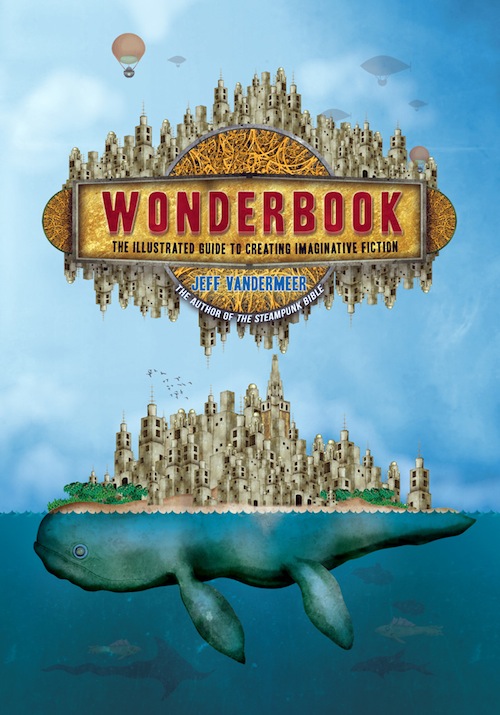What subject will always spark that light in a writer’s eyes? That gets writers going for hours in conversation? Gives them another reason to socialize on mailing lists and forums and then out of the house tot readings, salons, and conventions? What gets them more enthusiastic than their current project is the art of writing itself. For people aspiring to be published, “How do you do it?” is always the standby question they ask each other.
Thankfully, there is a new, craftily-assembled, and beautifully-designed resource to shelf beside your dog-eared copy of Strunk & White’s The Elements of Style. That’s Jeff VanderMeer’s Wonderbook: The Illustrated Guide to Creating Imaginative Fiction.
I read Wonderbook twice. Once to absorb and reflect upon the information that VanderMeer puts together from the ground up: finding inspiration, constructing the nuts & bolts of fiction writing, developing characters and plot, and, of course, revision. Then, I read it a second time to fully absorb everything else: the sidebars, illustrated charts, the moments that The Disruption Dragon snaked its way down a margin, and the extra goodies that VanderMeer tends to stick in the back of his nonfiction books and anthologies. As someone who writes and edits, looking at the creative machine from the inside out (and vice versa) is fascinating. VanderMeer speaks from his vast experience as a writer/editor/anthologist/teacher/man of letters, I thought the book was the perfect way of picking his brain. In addition to a straightforward breakdown of different writing aspects, Wonderbook includes exercises and questions to ponder as a writer constructs their story.
Better yet, Wonderbook provides insights from other authors and editors as well. George R.R. Martin, Karin Tidbeck, Catherynne Valente, Nnedi Okorafor, Lauren Beukes, Charles Yu and plenty more give their strategies and advice for different aspects of writing. A lot of their anecdotes are conversational features, and for people I wasn’t familiar with, their feature gave a good reason to investigate their work further.
The bonus content on Wonderbook’s website is also a delight. Online materials include author interviews, more writing exercises, story drafts, and stages of Wonderbook’s own development. A look on the editorial side was highly educational: there is a roundtable featuring a slew of award-winning editors giving their critiques of a short story. The developmental edit notes from our own Liz Gorinsky for VanderMeer’s novel Shriek: An Afterword is also a special opportunity for any new writer to experience part of the professional editorial process (and I hope give them an appreciation of what a good one can accomplish). Basically, all of this alone is worth the price of the book, and having it free and complimentary to Wonderbook itself makes the guide an investment and not just a casual tool.
One of the aspects about Wonderbook I also want to mention is the sheer number of visual aids that are interspersed throughout. More than your typical plot progression lines, these are full-color, detailed, and whimsical charts featuring a cast of characters and innovative presentations. There is a disadvantage to this layout, however, when it comes to processing information. I kept getting sidelined by an unexpected graphic, chart, or caption that de-toured me into another reading experience. While this makes Wonderbook a lasting resource that can be returned for repeated readings, it also made it harder for me to concentrate at points, because I felt compelled to either skip passages or take breaks from literal sensory overload.
Like with other writing books, Wonderbook is very much about VanderMeer’s development as a writer as much as it is about the craft he speaks of. He name-drops a lot of writers and works that, unless you are browsing through his own personal reading stack, may not be as helpful to a beginner. He reinforces the adage, “Wanna write? Then read!” but leaves the reader an additional list to read through before they can attain an fuller understanding behind why he uses these examples (luckily, there is also an Index available for this very purpose). Would the book have benefited by including additional text excerpts as part of the book? Perhaps, but then it probably would’ve made Wonderbook twice as long (and it’s already a pretty weighty thing to lug around!) Keeping this guide on any writer’s desk, whether amateur or experienced, though, is a must. Whether viewed as a beautiful book on writing or a writing book that’s also a beauty, Wonderbook will leave the reader flipping through endless hours of creative contemplation.
Wonderbook is available now from Abrams Image
Ay-leen the Peacemaker still has her copy of Strunk & White that she got when she was 13. Now, she works at Tor Books, runs the multicultural steampunk blog Beyond Victoriana, pens academic things, and tweets.










